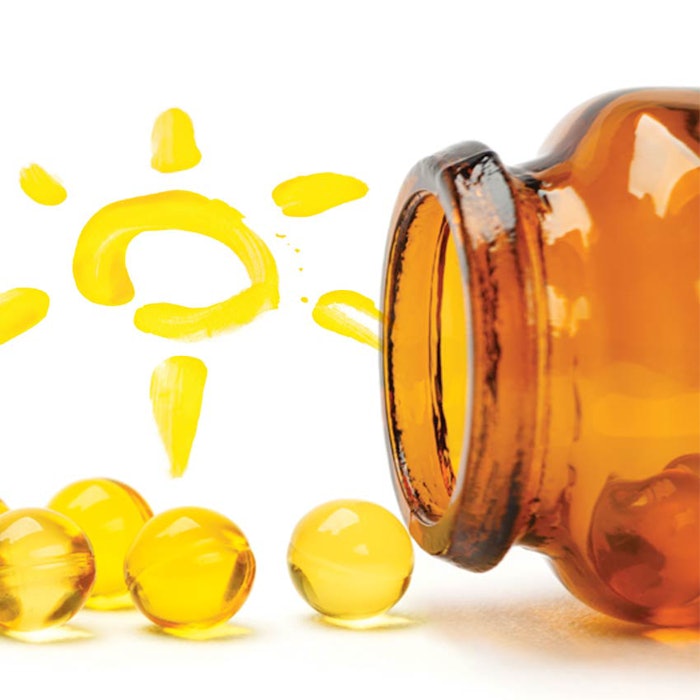
Scientists estimate that nearly 42% of U.S. adults1 and 70% of all children2 suffer from a vitamin D deficiency, the effects of which can range from decreased energy to rickets. On top of building strong bones and a healthy immune system, the hormone vitamin D has been proven to help people lose weight, manage the symptoms of depression and even lower the chances of getting many forms of cancer, heart disease and type 2 diabetes.
There are three sources from which humans can get vitamin D: sun exposure, supplements and food. The first of these is controversial and complex. Controversial because while sun exposure can lead to increased levels of vitamin D, it can also subject an individual to skin damage and skin cancer. Complex because the sun does not supply the skin with vitamin D, but rather starts the process for its production.
Skin naturally contains a precursor to vitamin D, and when the sun’s UVB rays touch the skin, they convert the precursor to vitamin D3 or cholecalciferol, which then follows a metabolic pathway through the liver and finally to the kidneys where it is converted into calcitriol. Vitamin D obtained from food or supplements follows this same metabolic highway to become that active form of vitamin D3.
Vitamin D is not a one-size-fits-all hormone, and an individual’s vitamin D requirement depends on their size. Having the right amount of vitamin D is a careful balance. As stated, its deficiency can cause a range of issues, but excess vitamin D can lead to calcium in places it should not be, as well as kidney stones and other problems.
Before this article discusses vitamin D-deficient skin disorders, correct dosage and the esthetician’s role, it will first provide context to the complexity of UVB exposure through key aspects of human ancestry.
Evolution and Revolution
The amount of pigmentation in our skin today directly relates to the UVB levels to which our ancestors were exposed. The current understanding of evolution places the first appearance of Homo sapiens in Africa, one of the continents with the highest concentration of UVB-rich sunlight due to its proximity to the equator. To reap the benefits of UVB without irradiating ourselves, evolution developed extra melanin in skin. This darker pigment served as a natural sunscreen (approximately an SPF of 4- 6), absorbing the brunt of UVB while allowing a small amount in for the health benefits such as those stated above. This system worked great until humans began migrating from Africa to places in the world with less light.
Due to the tilt of the Earth’s axis, sunlight filters through more of the atmosphere the further away a location is from the equator, which reduces the amount of UVB that makes it through. Thus, people who settled in northern areas had difficulty absorbing UVB. Over time, paler complexions developed to allow more vitamin D production. Such evolution produced the rainbow of human skin tones we see today. Not only was there less sunlight in these northern climates, but periods of low light developed when crowds of people began to industrialize spaces. With multi-storied buildings and factories surrounded by narrow, dark alleys, and sky-rocketing increases in pollutants and toxins, the amount of sun rays reaching these regions and their inhabitants plummeted even further.
With the Industrial Revolution came various technological advancements such as a broadened means of transportation. People with fairer skin were now able to rapidly migrate to regions with plenty of sunshine. However, their skin did not have time to adapt to these new sunny environments, and excessive sun exposure led to severe health conditions such as skin cancer. This eventually prompted the creation of sunscreens and led some people to avoid the sun altogether.
Vitamin D Deficiency and Skin
Although sun exposure can lead to a number of health consequences, so can the lack of vitamin D. According to the National Institutes of Health’s Office of Dietary Supplements (ODS), adults need from 600 to 800 international units (I.U.) of vitamin D daily.3 This standard was set when rickets, a disorder that causes the softening of bones, was found to be preventable with sufficient vitamin D. Sarfraz Zaidi, M.D., suggests much higher levels, stating, “Upon my extensive clinical experience, I recommend vitamin D3 in a daily dose of 5,000-10,000 I.U. (125-250 micrograms) for most of my patients.”4
Many relatable skin disorders and abnormalities such as psoriasis, vitiligo, eczema and urticaria can be linked to vitamin D deficiency and at the very least, vitamin D could help these conditions. In relation, following is an overview of these conditions and their relation to vitamin D.
Vitiligo. Vitiligo or Vitiligo vulgaris is an autoimmune disorder caused by vitamin D deficiency. This disorder enables the immune system to attack and kill melanocytes in the skin, which leads to a loss of skin pigmentation. Individuals with vitiligo often have blotchy patches of depigmented areas on their body.
Psoriasis. Psoriasis is also an autoimmune disorder in which immune cells mistakenly start to attack skin cells. Vitamin D deficiency and stress play crucial roles in the development of psoriasis.
Eczema. Also known as atopic dermatitis, eczema is a chronic skin condition that usually starts in childhood and may persist throughout adulthood. Patients with eczema often experience recurring, itchy skin rashes; many also suffer from asthma, an allergic disorder well-known to be associated with vitamin D deficiency. The causes of atopic dermatitis are not fully clear, but genetics as well as precipitating factors including pollens, skin irritants, skin infections, dust mites, food allergies and stress are key factors. Vitamin D can help play an important role in normalizing and stabilizing the immune system’s functions.
Urticaria. Urticaria refers to hives on the skin that are typically raised, reddish and itchy. The causes of urticaria include stress; allergies to food, drugs or environmental agents; and autoimmune dysfunction. Since vitamin D is directly involved in the health of the immune system, it seems logical that vitamin D supplementation should have a role in the treatment of chronic urticaria.
Vitamin D Supplementation
Although there are many reasons people develop skin disorders and other ailments, vitamin D deficiency is a common and easily treatable cause. Unfortunately, it often remains undiagnosed and untreated—despite discoveries in recent years that vitamin D is not only important for the health of bones, but plays a crucial role in the health of almost every organ in the body, including skin (the body’s largest organ). Vitamin D also is important for the prevention and treatment of chronic fatigue, muscle aches and pains, cancer, diabetes, heart disease, high blood pressure, osteoporosis, autoimmune disorders, kidney failure, dental problems, neurologic disorders and depression.
The benefits to getting the correct amount of vitamin D are astounding, but a pandemic of vitamin D deficiency currently exists. This is due mainly to our modern lifestyles, misconceptions about vitamin D and sub-optimal doses of vitamin D in supplements and calcium formulas. The amount of vitamin D your skin can synthesize depends upon several factors including: geographical location, season, time of day, skin tone, age, sunscreen lotions and air pollution.
Humans need a significant amount of sun exposure on naked skin produce enough vitamin D; however, this also subjects them to skin damage and cancer, especially in fair-skinned individuals. To get the most vitamin D absorption without increasing the chances of developing skin cancer, a user can opt for physical and micronized physical sunscreens, which block and deflect the sun’s rays. Also, fortified foods such as milk contain small amounts of vitamin D. In short, the best way to get an optimal level of vitamin D is through sensible sun exposure and daily vitamin D supplements, which are available both over-the-counter and by prescription. Supplements taken under the tongue may offer the best absorption.
The Esthetician’s Role
To achieve total wellness in clients, you must offer a complete package of skin health information. This includes being knowledgeable about vitamins and minerals that are necessary for skin health. While estheticians often are not able to give nutritional advice without proper training, they can recognize deficiencies and recommend a healthy diet, a consultation with a nutritionist/pharmacist and the right sun protection. Offer clients wellness education. You can place facts about vitamin D and skin wellness on water bottle labels, in-house tea bags or in key locations in your space.
More and more spas are adding supplements and other beauty nutrition, and given the information above, spas should consider adding supplements containing vitamin D if it makes sense for their spa and their clientele. As noted above, physical sunscreens containing titanium dioxide or zinc oxide should be recommended to clients. Some spa lines also carry supplemental powders and waters. Investigate those and carry them if they are a good fit. Or, have a smoothie bar in your spa that offers vitamin D-rich foods. Clients look to us as the experts for their skin’s health. Let’s put into practice what we preach and offer the right nutrition and skin care to support their skin health.
REFERENCES
- www.sciencedirect.com/science/article/pii/S0271531710002599 (Accessed Jan 25, 2016)
- www.cnn.com/2009/HEALTH/08/03/vitamin.d.children/index.html?_s=PM:HEALTH (Accessed Jan 25, 2016)
- https://ods.od.nih.gov/factsheets/VitaminD-Consumer/ (Accessed Jan 25, 2016)
- S Zaidi, Power of Vitamin D, 3rd ed., 3167-3171 (2015)











